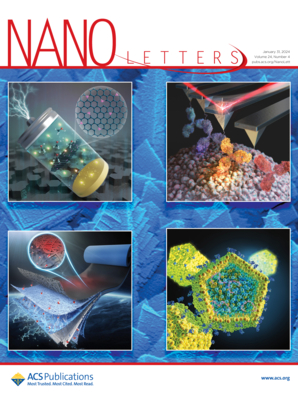深度学习模型辅助脯氨酸与羟脯氨酸的单分子 SERS 识别
IF 9.6
1区 材料科学
Q1 CHEMISTRY, MULTIDISCIPLINARY
引用次数: 0
摘要
鉴别低丰度羟基化是早期疾病诊断和治疗开发的关键和未满足的需求,因为17.01 Da的小羟基。虽然单分子表面增强拉曼光谱(SERS)传感器可以检测羟基化,但随后的数据分析受到信号波动和柠檬酸盐的强烈干扰。在这里,我们使用我们的等离子体粒子孔传感器、单分子SERS光谱的出现频率直方图和一维卷积神经网络(1D-CNN)模型来实现羟基化的单分子识别。直方图提取了整个数据集的光谱特征,克服了信号波动,帮助柠檬酸盐取代的孔内颗粒传感器产生干净的羟基化信号,用于模型训练。结果表明,1D-CNN模型首次成功识别了脯氨酸和羟脯氨酸的单分子SERS信号,准确率达到96.6%。直方图进一步验证了1D-CNN模型提取的特征与羟基化诱导的光谱变化相对应。本文章由计算机程序翻译,如有差异,请以英文原文为准。

Single-Molecule SERS Discrimination of Proline from Hydroxyproline Assisted by a Deep Learning Model
Discriminating low-abundance hydroxylation is a crucial and unmet need for early disease diagnostics and therapeutic development due to the small hydroxyl group with 17.01 Da. While single-molecule surface-enhanced Raman spectroscopy (SERS) sensors can detect hydroxylation, subsequent data analysis suffers from signal fluctuations and strong interference from citrates. Here, we used our plasmonic particle-in-pore sensor, occurrence frequency histogram of the single-molecule SERS spectra, and a one-dimensional convolutional neural network (1D-CNN) model to achieve single-molecule discrimination of hydroxylation. The histogram extracted spectral features of the whole data set to overcome the signal fluctuations and helped the citrate-replaced particle-in-pore sensor to generate clean signals of the hydroxylation for model training. As a result, the discrimination of single-molecule SERS signals of proline and hydroxyproline was successful by the 1D-CNN model with 96.6% accuracy for the first time. The histogram further validated that the features extracted by the 1D-CNN model corresponded to hydroxylation-induced spectral changes.
求助全文
通过发布文献求助,成功后即可免费获取论文全文。
去求助
来源期刊

Nano Letters
工程技术-材料科学:综合
CiteScore
16.80
自引率
2.80%
发文量
1182
审稿时长
1.4 months
期刊介绍:
Nano Letters serves as a dynamic platform for promptly disseminating original results in fundamental, applied, and emerging research across all facets of nanoscience and nanotechnology. A pivotal criterion for inclusion within Nano Letters is the convergence of at least two different areas or disciplines, ensuring a rich interdisciplinary scope. The journal is dedicated to fostering exploration in diverse areas, including:
- Experimental and theoretical findings on physical, chemical, and biological phenomena at the nanoscale
- Synthesis, characterization, and processing of organic, inorganic, polymer, and hybrid nanomaterials through physical, chemical, and biological methodologies
- Modeling and simulation of synthetic, assembly, and interaction processes
- Realization of integrated nanostructures and nano-engineered devices exhibiting advanced performance
- Applications of nanoscale materials in living and environmental systems
Nano Letters is committed to advancing and showcasing groundbreaking research that intersects various domains, fostering innovation and collaboration in the ever-evolving field of nanoscience and nanotechnology.
 求助内容:
求助内容: 应助结果提醒方式:
应助结果提醒方式:


